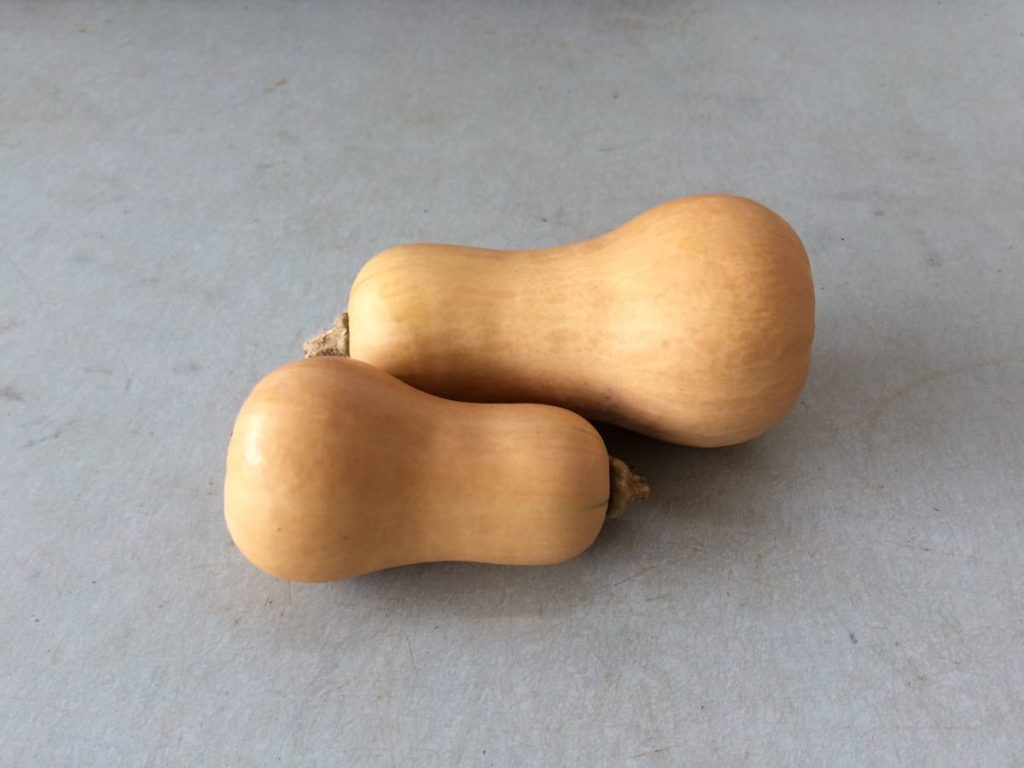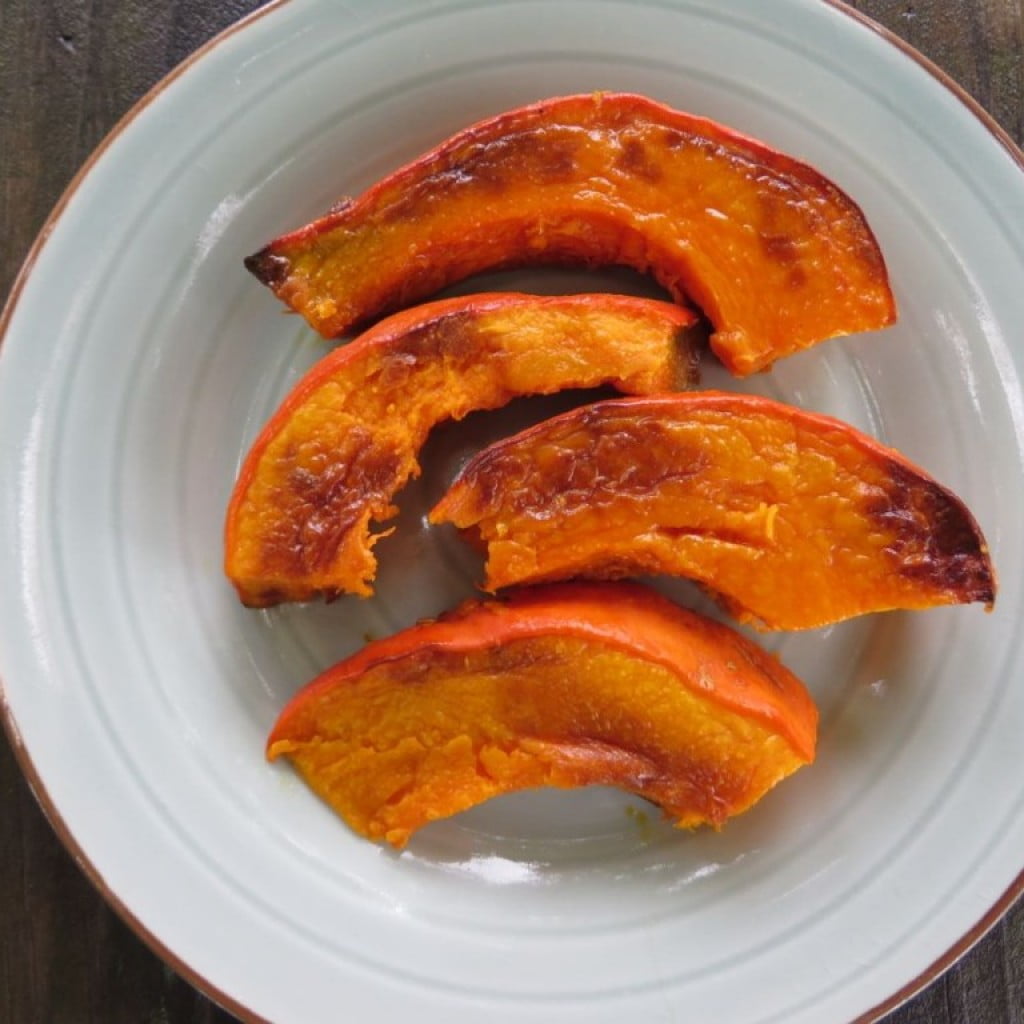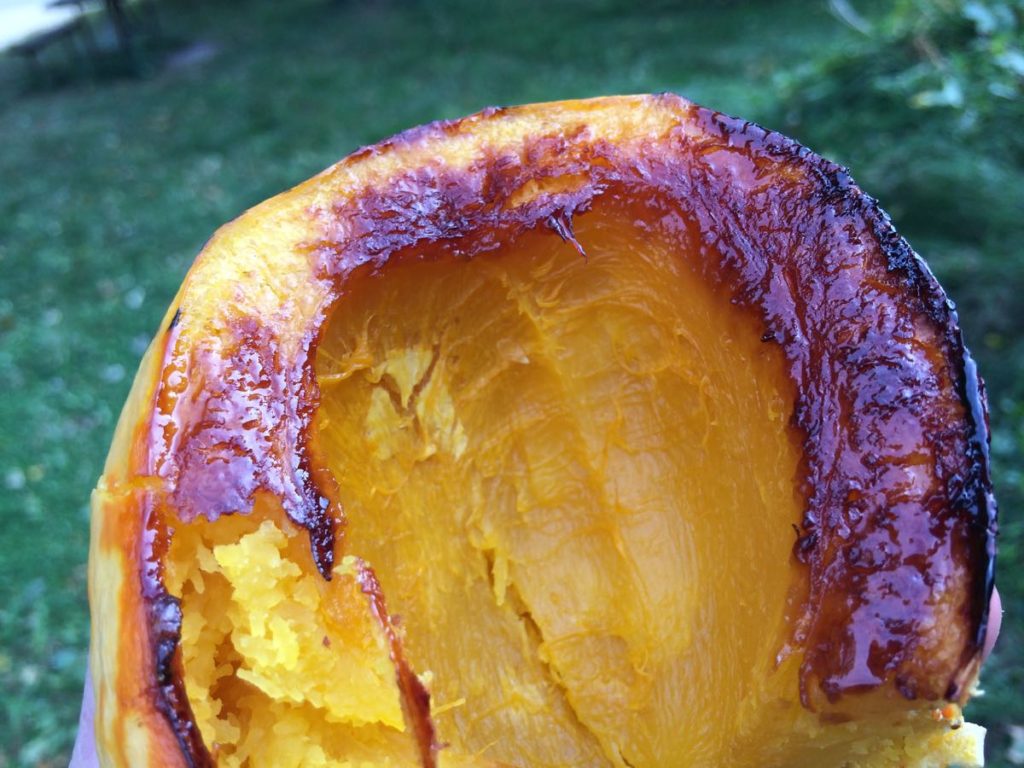Week #18, Sept 20, 2018
- On: September 19, 2018
 0
0
This week’s winter squash
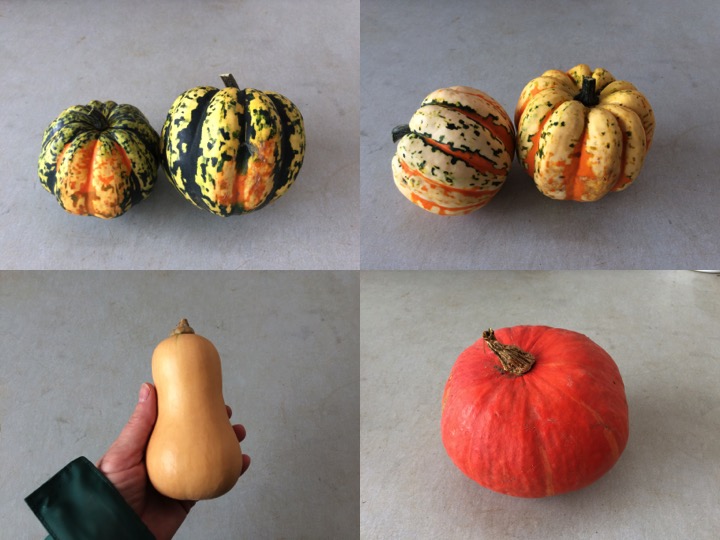
Clockwise from top left, ‘Carnival’ acorn, ‘Festival’ acorn, ‘Sunshine’ kabocha, ‘Butterscotch’ butternut
Almost everyone gets one or two acorn squash this week. One site gets Sunshine and another gets Butterscotch. All are cured and ready to eat.
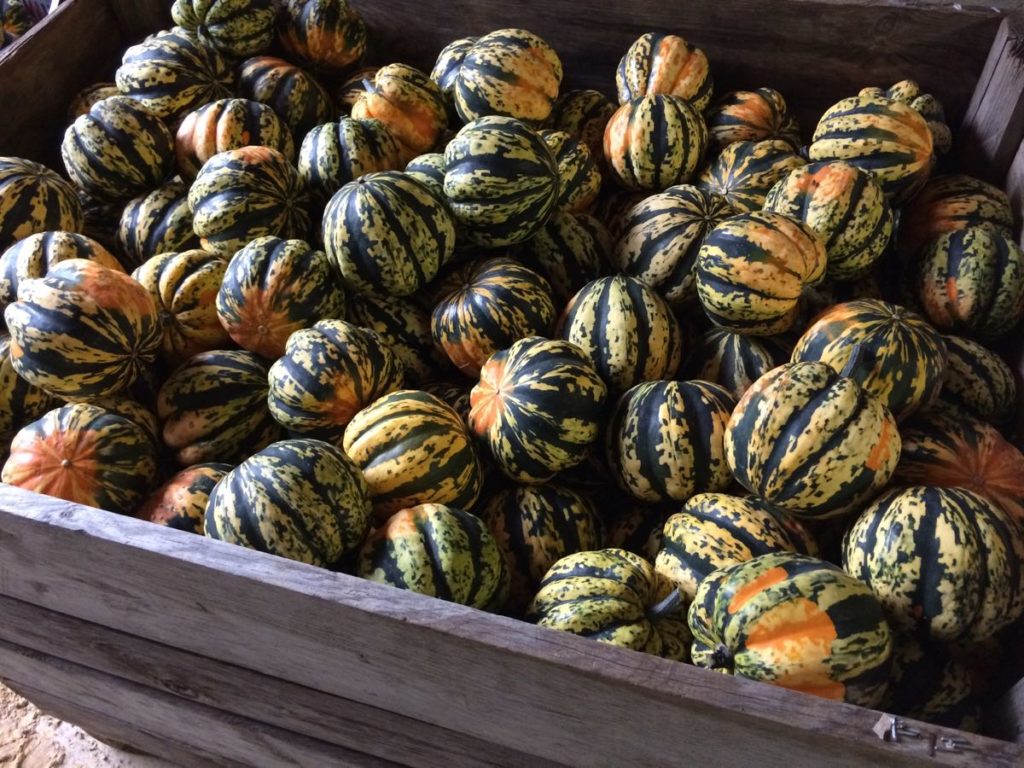
A wooden bin of Carnival squash
Acorn squash (Carnival, Festival this week) – These are distractingly beautiful, with stripes and patterns in yellow, green, orange and white. We used to grow all-green acorn squash but stopped because we think the newer striped varieties taste better and are the plants are more vigorous.
Preparation: Acorn squash have a central cavity perfect for stuffing. Prepare your favorite fully-cooked stuffing, e.g. a rice or quinoa mixture. Roast your squash as described below. Preheat the stuffing. Fill the cooked squash with stuffing, top with grated cheese and return to the oven until everything is hot.
Butterscotch butternut – These small (tiny?) squash are incredibly sweet and flavorful. We grew them as a test this year. We love the flavor, but are ambivalent about how small these ‘personal size’ squash are.
Preparation: Roast and eat with salt and pepper. They don’t need any embellishment.
Sunshine – Bright orange Sunshine have a mild, sweet flavor reminiscent of chestnuts. The skins are tender and edible. We find that Sunshine do not store well, because of the thin skins. Eat these soon.
Preparation: (i) Dry roasting brings out Sunshine’s delicate flavor. Cut into thick slices, toss with olive oil, and roast on a well-oiled cookie sheet at 425 oF until soft. The slices will fall apart if you overcook them but you have a fairly wide window to get them out of the oven successfully. Make sure to roast them until the cut surfaces are caramelized. Season with salt after they are out of the oven. Excellent with a yogurt-garlic-olive oil dip.
(ii) Sunshine have a central cavity amenable to stuffing. See acorn squash above.
Winter Squash Primer
This year’s winter squash crop is excellent. The dry spell was perfectly timed to bring in the squash without damage. We should have enough for a steady supply of squash or sweet potatoes over the coming weeks.
Expected life: Some winter squash varieties are ready to eat soon after harvest, others store deep into winter. This week’s varieties are cured and ready to eat. Plan to eat these early varieties within two to four weeks, on the shorter side for the kabocha.
Storage: Winter squash store best at room temperature with good air circulation. No cooler than 50 degrees. On your kitchen counter works. Do not cover.
To make squash easier to cut: Microwave on high for 30 to 60 seconds, depending on size of the squash. This will soften the rind and flesh, making it much easier to cut.
Beth’s favorite simple preparation (acorn or butternut): Winter squash are easily roasted in a 400F oven.
– Split in half with a sharp knife.
– Scoop out and discard seeds.
– Run the squash briefly under running water, then shake off the excess water. Place cavity-side-down on an oiled baking sheet. The little bit of moisture seals the squash to your roasting pan. The water soon evaporates, allowing the squash to brown and caramelize. Caramelization really boosts the flavor.
– Roast at 400F until easily pierced with a fork, 30 – 45 minutes depending on size. Flip over while hot. Add a little butter to melt and some seasoned salt. Cut into wedges and eat.
Can you eat the rind? Kabocha rind is thin and edible. Rinds for acorns and butternuts are thicker. It’s your choice whether to eat them or not. Steve eats them. I don’t.
Veggie List and Veggie Notes
Week #18; Sept. 20/21, 2018
Weekly, purple EOW, and sun SMP shares
Broccoli
Cauliflower
Winter squash, 1 or 2
Kale, 1 big bunch
Romano beans, 0.9 – 1 lb
Grape or cherry tomatoes, 1 pint
Bell or frying pepper, 1
Yellow onions, ~2
Jalapeno chile
– Some sites get 1 – 2 zucchini.
– Some sites get globe eggplant.
Next week’s box will probably contain green cabbage, winter squash, broccoli, bok choy, peppers, onions and more.
RECIPES
Visit our 2018 Recipe Log or our 2017 Recipe Log or join our Facebook discussion group.
ROMANO BEAN RECIPES
This week’s beans are suited to braising. Let’s gather and repeat last week’s recipe links, so you don’t have to hunt for them.
– Lauren’s favorite: African Peanut Stew .
– Former crew member Jon Fagan’s favorite: Braised Green Beans with Tomato and Fennel Seeds (in previous newsletter, scroll down).
– Beth’s favorite: Sausages and Summer Beans with Tomatoes & Caramelized Onions. (in previous newsletter, scroll down).
– Lemony Braised Romano Beans
– Romano Bean, Potato and Meatball Stew
LOCAL THYME/ Comforting Classics
Cheesey Cauliflower Pasta
Easy Pot Pie
Quick Honey Nut Acorn Squash
Garlic Parmesan Kale Chips
LOCAL THYME/ Outside the Box Recipes
Cauliflower Gallette Crust
Sweet Spicy Broccoli and Pepper Stir Fry
Acorn Squash and Caramelized Onion Pizza
Kale Broccoli Soup
LOCAL THYME/ Quick & Easy Meal
Fish Tacos with Cherry Tomato and Pepper Salsa
RECIPES FROM LAUREN
SLOW COOKER CARAMELIZED PORK RAMEN WITH CURRY ROASTED VEGETABLES
Adapted from Half Baked Harvest
If you aren’t a person who loves big, bold flavors, well then this recipe may not be for you. Ramen like this is certainly not for the faint of heart. It has a lot of spice, a lot of salt, and a lot of richness. It is also incredible. But if flavors that big aren’t you thing, well then maybe just make the slow cooker pork and make the roasted vegetables and eat them sans noodles and sans broth. The broth is where the big, bold flavors are hidden. Lauren.
Serves 8-10.
Takes a long time (because slow cooker), but I recommend estimating about an hour of active cooking time + 4 (or more) hours in the slow cooker.
2-3 pound pork shoulder roast, bone-in or out is fine
1 red pepper, seeded and cut into long, skinny strips
1 yellow onion, divided
6 cups water
1/2 cup soy sauce (or tamari) + 5 tablespoons, divided
1/4 cup rice wine vinegar + 2 tablespoons, divided
3 tablespoons fish sauce, divided
1 tablespoon sambal oelek or sambal nyonya (or other hot sauce that you happen to have on hand)
1 lime, juiced
1 tablespoon Kosher salt
1 teaspoon black pepper
5 tablespoons brown sugar, divided
3 tablespoons + 1 teaspoon curry powder, divided
1 teaspoon ground allspice
1 teaspoon ground ginger
1/2 teaspoon ground coriander
1/2 teaspoon ground cumin
1/2 teaspoon cinnamon
1/4 teaspoon ground cloves
4-5 cups chopped acorn squash, seeded first (1 large squash)
4 cups chopped cauliflower (1 medium head)
1 zucchini, halved and sliced
1/4 cup olive oil
2 tablespoons toasted sesame oil
6-8 ounces ramen noodles (real ones from the Asian market or plain old ramen packets with the flavor packets removed are both fine)
1 jalapeno, thinly sliced, optional
Soft-boiled eggs (if you’re feeling extra ambitious), optional
- Get your slow cooker going. Add the pork roast to the center. Cut onion in half. Set aside one half to thinly slice just before serving. Dice other half onion and nestle around pork in slow cooker along with peppers.
- Pour water, 1/2 cup soy sauce, 1/4 cup rice wine vinegar, 2 tablespoons fish sauce, sambal oelek (or hot sauce), and lime juice into slow cooker. Add salt, pepper, 1 tablespoon brown sugar, 1 teaspoon curry powder and the rest of the spices. Give things a quick stir.
- Cover the slow cooker and cook on high for 4-6 hours or low for 6-8 hours. If you have more time than that, just turn it to keep warm after the initial 8 hours. I tend to do the first cooking over night and then leave it on low all day while I’m at work. Extra steeping won’t hurt you here, I promise.
- About an hour before you are ready to serve your ramen, preheat the oven to 400 degrees.
- Toss acorn squash, cauliflower and zucchini with olive oil, 3 tablespoons brown sugar, 1 tablespoon soy sauce, and remaining curry powder (3 tablespoons) and fish sauce (1 tablespoon) in a large bowl. Lay out on two large baking sheets. Bake in preheated oven for 50-60 minutes, rotating pans and vegetables throughout cooking at least once.
- While that roasts, and once the pork is finished cooking, remove from slow cooker. Remove any bones and shred with two forks. Add ramen noodles and cook on high for 12 minutes. Once finished, add back half the shredded pork and reduce heat to “keep warm” setting.
- In a large skillet, heat sesame oil over medium heat. Add other half shredded pork followed by the remaining brown sugar (1 tablespoons), soy sauce (2 tablespoons) and rice wine vinegar (2 tablespoons). Cook for 10 minutes, stirring every couple minutes so the bottom layer of pork gets crispy and almost caramelized.
- Serve ramen soup with crispy pork, roasted veggies, and raw sliced onion as well as jalapeno and soft-boiled eggs (if using).
.
BROCCOLI & KALE SALAD WITH FRIED ONIONS & PEANUTS
The two recipes this week really pair wonderfully together using several similar ingredients so use this week’s box as an excuse to go out a buy bottles of rice wine vinegar and higher quality fish sauce! Lauren.
Takes 25 minutes.
Serves 2 as a meal or 4 as a side dish.
Vegetable oil
1 large onion, halved and sliced
1/2 cup flour
2 tablespoons Kosher salt
1 head broccoli
3-4 stems curly kale, stems removed and chopped small
1/4 cup peanut oil (don’t have peanut oil? use 1/4 cup of the oil you fried your onions in instead)
1/4 cup rice wine vinegar
1 tablespoon brown sugar
2 teaspoons fish sauce
3/4 cup roasted peanuts, roughly chopped
Pinch red pepper flakes, to taste
- In a large skillet heat 2 inches of vegetable oil over medium high heat.
- While the oil warms, prepare your onions. In a small bowl, toss onion with flour and salt until well coated.
- Once oil is just starting to glisten, it is at the right temperature. Add half the onions and use a fork to make sure all the onions are submerged. Fry until golden brown, about 4-5 minutes. Drain on paper towels. Fry second half of onions and drain as before. Leave onions while you prepare your salad.
- Cut your broccoli by removing 3-4 inches of the stem and then cutting the head in half. Slice the head thinly so you end up with long, elegant pieces of broccoli. Place in large bowl with the kale.
- In a small bowl, combine peanut oil, vinegar, brown sugar and fish sauce. Whisk until smooth. Pour over vegetables and massage until uniform and well-coated.
- Serve salads with fried onions, peanuts and red pepper flakes. Taste and season with salt and pepper as desired. If eating part of the salad later, store separate from peanuts and fried onions so they don’t lose their crunch.
.

